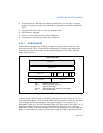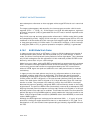
Vol. 3 6-19
INTERRUPT AND EXCEPTION HANDLING
not permit transfer of execution to an exception- or interrupt-handler procedure in a
less privileged code segment (numerically greater privilege level) than the CPL.
An attempt to violate this rule results in a general-protection exception (#GP). The
protection mechanism for exception- and interrupt-handler procedures is different in
the following ways:
• Because interrupt and exception vectors have no RPL, the RPL is not checked on
implicit calls to exception and interrupt handlers.
• The processor checks the DPL of the interrupt or trap gate only if an exception or
interrupt is generated with an INT n, INT 3, or INTO instruction. Here, the CPL
must be less than or equal to the DPL of the gate. This restriction prevents
application programs or procedures running at privilege level 3 from using a
software interrupt to access critical exception handlers, such as the page-fault
handler, providing that those handlers are placed in more privileged code
segments (numerically lower privilege level). For hardware-generated interrupts
and processor-detected exceptions, the processor ignores the DPL of interrupt
and trap gates.
Because exceptions and interrupts generally do not occur at predictable times, these
privilege rules effectively impose restrictions on the privilege levels at which excep
-
tion and interrupt- handling procedures can run. Either of the following techniques
can be used to avoid privilege-level violations.
• The exception or interrupt handler can be placed in a conforming code segment.
This technique can be used for handlers that only need to access data available
on the stack (for example, divide error exceptions). If the handler needs data
from a data segment, the data segment needs to be accessible from privilege
level 3, which would make it unprotected.
• The handler can be placed in a nonconforming code segment with privilege level
0. This handler would always run, regardless of the CPL that the interrupted
program or task is running at.
6.12.1.2 Flag Usage By Exception- or Interrupt-Handler Procedure
When accessing an exception or interrupt handler through either an interrupt gate or
a trap gate, the processor clears the TF flag in the EFLAGS register after it saves the
contents of the EFLAGS register on the stack. (On calls to exception and interrupt
handlers, the processor also clears the VM, RF, and NT flags in the EFLAGS register,
after they are saved on the stack.) Clearing the TF flag prevents instruction tracing
from affecting interrupt response. A subsequent IRET instruction restores the TF
(and VM, RF, and NT) flags to the values in the saved contents of the EFLAGS register
on the stack.
The only difference between an interrupt gate and a trap gate is the way the
processor handles the IF flag in the EFLAGS register. When accessing an exception-
or interrupt-handling procedure through an interrupt gate, the processor clears the
IF flag to prevent other interrupts from interfering with the current interrupt handler.
A subsequent IRET instruction restores the IF flag to its value in the saved contents


















